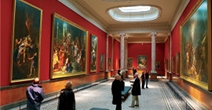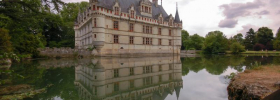 Home
Home- > Monuments France
- > Haute-Normandie
- > Seine-Maritime
- > Bonsecours
- > Basilique notre-dame de bonsecours
Basilique Notre-Dame de Bonsecours
The Middle Ages and its history is told on a marble plaque on the wall of the porch. The basilica succeeds two other buildings: Chapel Blosville, near the castle was mentioned around 750 as 1034. She belonged to the lords of Pavilly who yielded to the monks of Saint-Lô in 1186. This chapel was replaced in 1332 by a parish church destroyed in 1473 by troops of Charles the Bold and rebuilt before being itself replaced by the present building at the initiative of Father Godfrey, appointed in 1838 Blosville.
It still retains the old church, ruined by the French Revolution, the play's most important and most venerated statue of Our Lady of Bonsecours, polychrome wood of the sixteenth century and the century wooden stalls of the thirteenth century.
The first stone of the new building was laid March 4, 1840. The basilica was designed by architect Eugene Jacques Barthelemy in the Gothic revival style - indeed the first example of this style in France. It comprises a nave flanked by aisles, no transepts, a tower and spire above the west portal. The construction ended in 1844, the blessing took place in October this year. Pope Pius IX honored the sanctuary of Notre-Dame de Bonsecours the privilege of crowning July 15, 1870. Cardinal-Archbishop of Rouen Bishop Bonnechose crowned the Virgin May 24, 1880. On May 18, 1980 occurred the centenary celebrations of the coronation.
The interior of the basilica has the distinction of being completely painted, following the example of the Sainte-Chapelle. The organs of Aristide Cavaille-Coll was inaugurated by Lefebure-Wely November 20, 1857. They now have 3 keyboards, pedals, 32 stops. The buffet style is Gothic Revival.
Accommodation nearby
Latest news onBasilique Notre-Dame de Bonsecours
Opening hours
Open Monday to Friday from 2:00 p.m to 4:00 p.m.
Prices
Free
Tourism near
 Visit the city of Bonsecours
Visit the city of Bonsecours - 10 Museum
- 6 Monuments
Tours
 A week-end to discover Rouen
A week-end to discover Rouen
 Impressionist workshops in Etretat
Impressionist workshops in Etretat
 Regional Natural Park of the 'Boucles de la Seine normande'
Regional Natural Park of the 'Boucles de la Seine normande'
 On Arsène Lupin's footsteps
On Arsène Lupin's footsteps



































